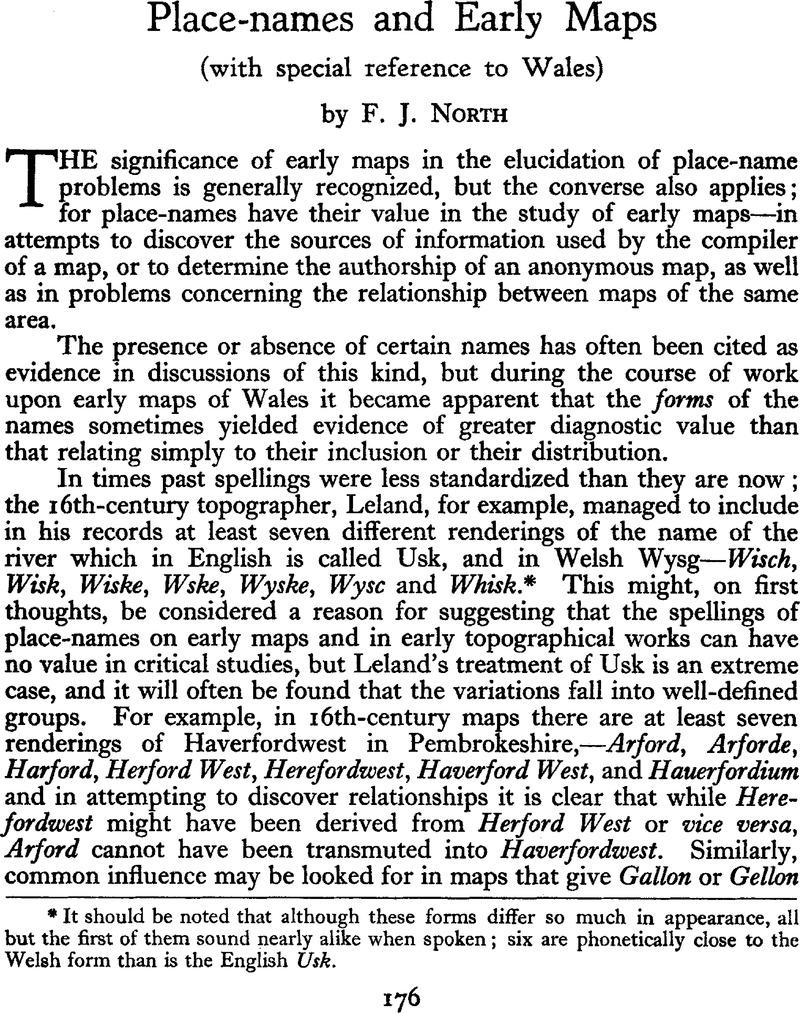No CrossRef data available.
Published online by Cambridge University Press: 02 January 2015

* It should be noted that although these forms differ so much in appearance, all but the first of them sound nearly alike when spoken ; six are phonetically close to the Welsh form than is the English Usk.
1 See notes by the late Egerton Phillimore in The Description of Penbrokshire, by George Owen of Henllys, Cymmrodorion Record Series, London, 1891, p. 207.
2 Information from my colleague Mr Ffrancis G. Payne.
3 Acts of the Privy Council, 1575-7.
4 F. J. North, ‘The Map of Wales before 1600 A.D.’ Archaeologia Cambrensis, vol. xc, 1935, also issued as a publication of the National Museum of Wales.
5 ‘Reproduction of the “Lily” Map, with a memoir by Edward Lynam’. G. H. Bean Library, Jenkintown, Penna, U.S.A., see also ‘The Map of Wales’, in Archaeologia Catnbrensis, 1935, xc, and R. A. Pelham, on ‘The Erroneous Position of Llandovery on Sixteenth century Maps’, Archaeologia Catnbrensis, 1932, LXXXVII, pp. 194-9.
6 F. J. North, Humphrey Lhuyd’s Maps of England and of Wales. Archaeologia Cambrensis, 1937, XCII.
7 L. T. Smith, The Itinerary in Wales of John Leland, 1906, p. 56.
8 Mackenzie, ‘Southwest Coast of Wales’, 1775.
9 Chart of St. George’s Channel, prepared for Nicholas Tindal’s edition of Paul de Rapin’s History of England, 1726-31.
10 Mackenzie’s ‘Chart of the Coast of Cardigan Bay’, 1775.
11 Mackenzie’s ‘Chart of the South Coast of Wales’, 1775.
12 W. Ashton. The Evolution of a Coast-line. London, 1920; O.T.Jones. Welsh Outlook, vol. 8 (1921) p. 310 ; C. F. Cliffe. Book of North Wales, London (1850).
13 F. J. North, ‘The Legend of Llys Helig—its Origin and its Significance’ Llandudno, Colwyn Bay and District Field Club, Llandudno, 1940.
14 The Cambrian Traveller’s Guide, London, 1813, col. 337.
* Information from Mr R. J. Thomas, Aberystwyth.
15 M. Mackenzie, Chart of the North part of Cardigan Bay, 1775.
16 Anonymous (Cottonian) map of the British Isles, 1534.
17 H. Lhuyd, England and Wales, 1573.
18 Mercator, British Isles, 1564.
19 Herman Moll, South Wales, 1724.
20 John Speed, Cardiganshire, 1610.
21 H. Lhuyd, Wales, 1573.
22 Mercator, Europe, 1554.
23 Saxton, England and Wales, 1583.
24 For an account of St. Padarn see S. Baring Gould and J. Fisher, Lives of the British Saints, vol. IV (1913), pp. 39-51.
25 E. Heawood, ‘Early Maps of Great Britain . . . Aegidius Tschudi’s Maps’, Geographical Journal, 1933, LXXXI, 39-43.
26 Libro del Conoscimiento, etc., ed. by M. J. de la Espada (1877) trans, by C. Markham. London, Hakluyt Society (1912).
27 Libro del Conoscimiento, ibid., p. 65.
28 See for example the charts by G. Benincasa, 1467, and G. Calapoda, 1552, both reproduced in Nordenskiold’s Periplus (1897), plates 33 and 25 respectively.
29 The Topography of Ireland, in The Historical Works of Giraldus Cambrensis, ch. XI, éd. T. Wright. Bohn, London (1863), p. 36.
30 A. W. Pollard, The Travels of Sir John Mandeville, the version of the Cotton Manuscript, London, 1900, p. 174.
31 I. G. Philip, Early Maps, ANTIQUITY, 1937, XI, 486-9 ; E. G. R. Taylor, Early Maps and Tide Tables, ibid. 1938, XII, 219-23.
32 Reproduced in A. E. Nordenskiold Periplus, Stockholm, 1897, plate VII.
33 Map of Great Britain and Ireland in the Ortelius Atlas of 1570.
34 Luke Fox, North-West Fox, or Fox from the North-west passage, 1635.
35 Information from early letter books in the Ordnance Survey archives, examined by kind permission of the Director General, during the course of investigation into the history of geology in this country.
36 The Assistant Surveyor was himself wrong in writing Caermarthenshire instead of Carmarthenshire.